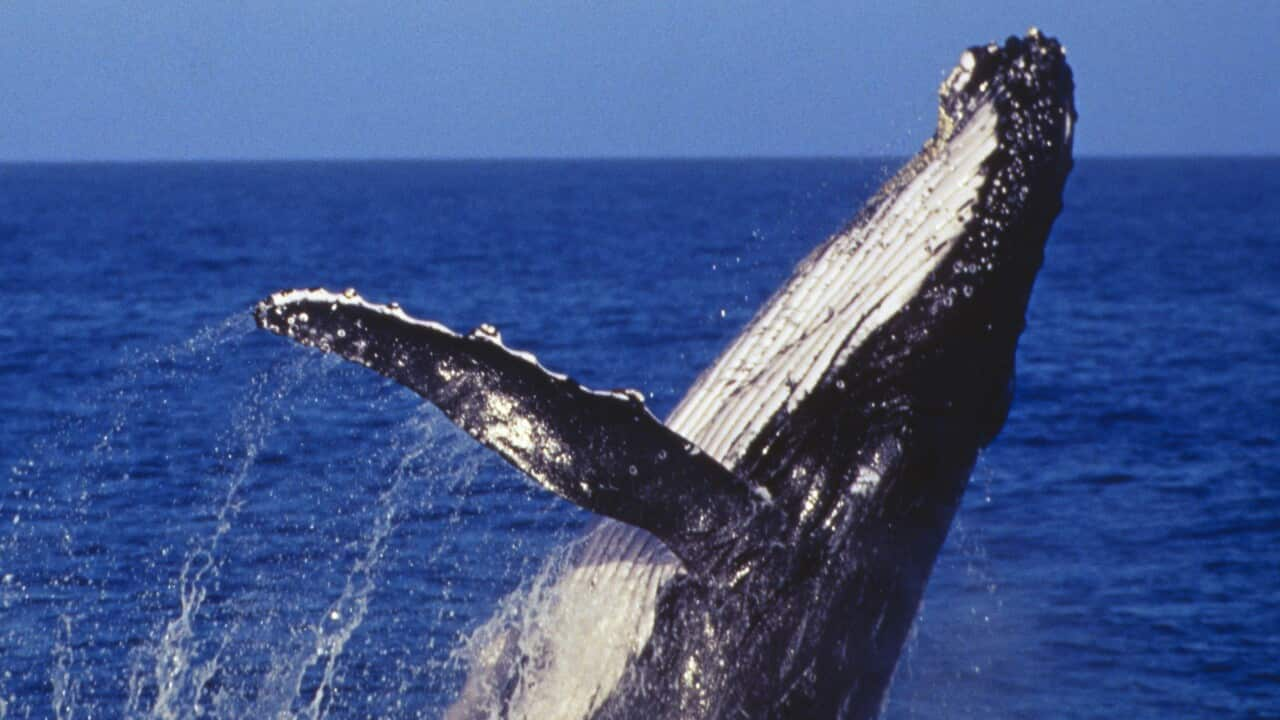Key Points
- The humpback whale migration season has started along Australia’s east coast.
- At least 32 whales become tangled in fishing gear every year, which authorities want to prevent.
- True figures of whales injured during migration season are believed to be even higher.
In December last year, a young humpback whale washed up dead on a NSW beach.
It had been caught in fishing rope and floats, becoming exhausted as it tried to swim the route of its annual migration along Australia’s east coast.
Despite rescue teams disentangling it, it died days later.
Dr Olaf Meynecke, a marine scientist at Griffith University, said the whale was in a bad way after becoming trapped.
“It was quite obvious to see from the footage that this was an animal that had really starved over a couple of weeks, it was quite thin, and it was also covered in sea lice that usually multiply quite quickly when those whales start to slow down,” he said.
Divers look to free an entangled humpback whale off Yamba in northern NSW. Source: AAP / AP
Meynecke said more needs to be done to prevent whale entanglements.
Over the past five years, the NSW National Parks and Wildlife Service said it had received an average of 32 reports of entangled whales per year.
More than 80 per cent of those entanglements involved fishing ropes and floats.
Meynecke said this is only the number of whales that humans have encountered, and the true figure is likely double.
Commercial fishers like Mitch Sanders want to do something about it.
A trap fisherman working mainly out of Terrigal and Pretty Beach on the NSW Central Coast, Sanders has joined a program run by Oceanwatch Australia aiming to reduce whale entanglement risk from fishing gear.
“We don’t want entanglements either, we lose our gear, it costs us time and money to get the gear back,” he said.
“So [we want to do] whatever we can do to work side by side with the whales, because they’re not going anywhere, so we’ve got to make sure that we’re viable and make sure that we do whatever we can to avoid entanglements.”
New technologies
Sanders is trialling new technologies like a ropeless attachment for his traps, designed in the United States.
Instead of running a rope through the ocean, the device contains rope inside a metal cage, which is only released once the fisher triggers it to unlock electronically, so they can retrieve the trap.
However, the devices are expensive and Australian fishers work differently from their US counterparts.
“It works, it’s very good, but it’s cumbersome and very time-consuming, and as we run single traps on every rope, over there they’re running up to 40 traps on one rope,” Sanders said.
“So, if it takes a bit longer to get that first one to the surface, it’s not so bad, but if we have to do it for every trap, it makes it a bit hard.”
Humpback whale populations along Australia’s east coast have recovered significantly since whaling was banned, increasing from a few hundred in the 1960s to approximately 40,000 today.
OceanWatch CEO Lowri Pryce said it means the oceans are extra busy.
“The fishermen are very aware of the number of whales increasing over many, many years. We’re very much looking at co-existence, we want the whales to migrate safely, having safe passage, but we also want fishers to have safe passage,” she said.
Pryce said as part of the program, Australian fishers are talking with their international counterparts, particularly those in the US, Canada and New Zealand.
“We are really trying to hunt down as many ideas as possible and then connect and bring people over so we can adapt. Every operation is very different, so having that suite of different gears is really important,” she said.
Calls for consistent fishing regulations
Fishing regulations vary across Australia, but scientists like Meynecke are calling for a unified approach to prevent whale entanglements.
“There have been some smaller projects to address it, but there is no major attempt to actually mitigate the entanglement and the rise of these entanglements,” he said.
Passionate citizens like Steve Trikoulis have stepped up.
He’s the vice president of the Organisation for the Rescue and Research of Cetaceans in Australia, a non-profit organisation which focuses on rescuing and protecting marine mammals, including whales.
“Generally, what happens is you’ll see a whale breach or do a blow or anything like that, but what we’re looking for is like a leading trail behind the whale, because that then gives us an indication that something is entangled,” he said.
Meynecke said changes to the fishing industry are important, calling for more research into making mitigation technologies more accessible.
“If people were more aware of the fact that we actually have quite a lot of whales that are entangled in gear and that this is an ethical concern, but also simply an animal welfare concern for us to just make sure that this doesn’t really happen in the future.”
For the latest from SBS News, and .

